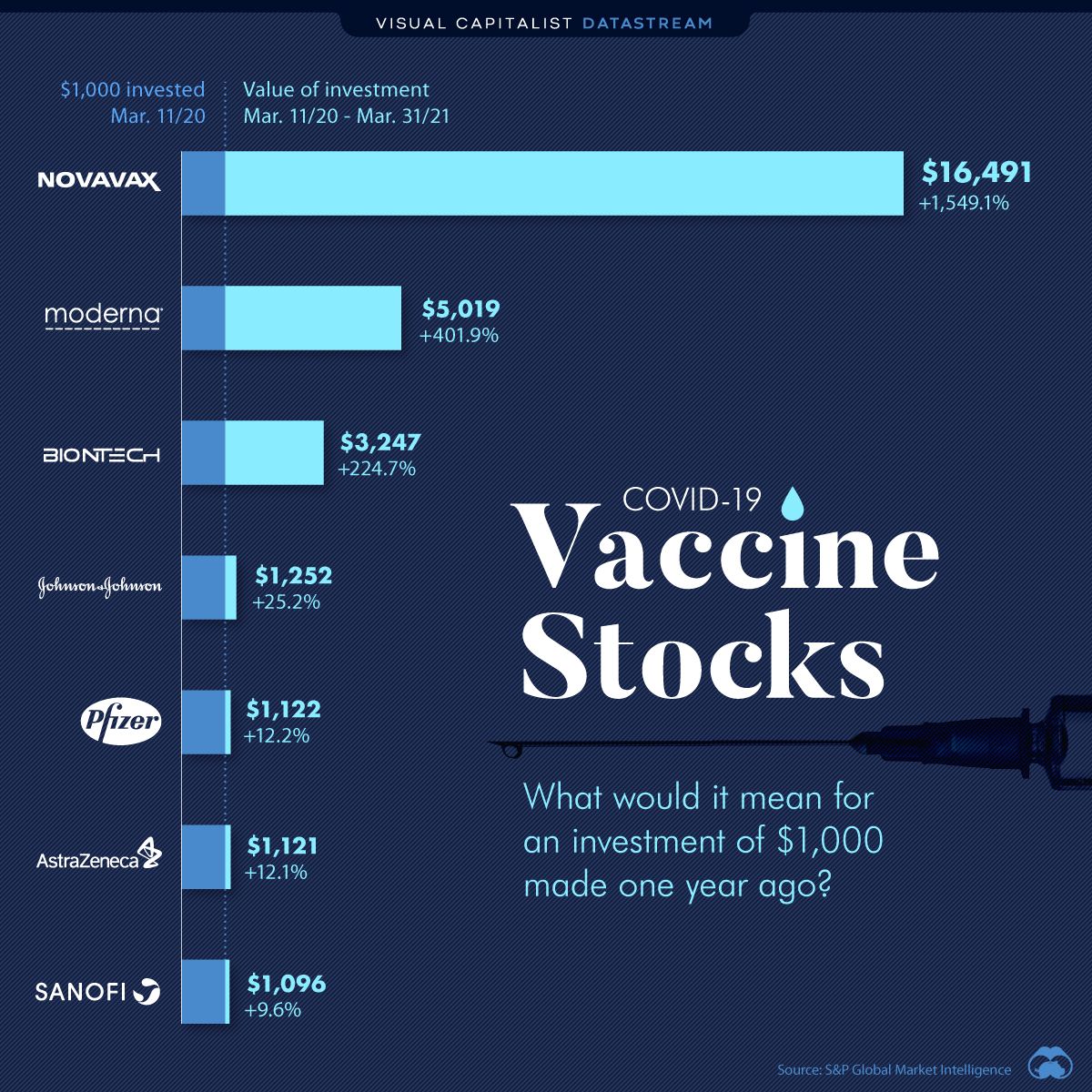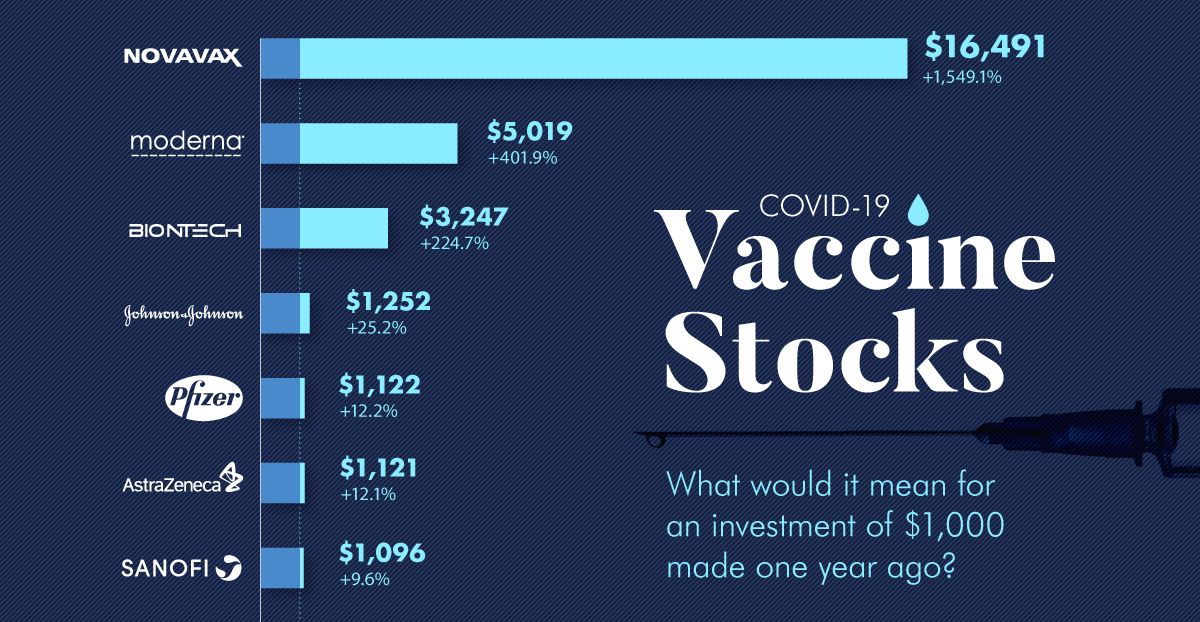Datastream
Here’s What $1,000 Invested in Vaccine Stocks Would Be Worth Now

The Briefing
- Three of seven COVID-19 vaccine stocks have outperformed the S&P 500 since the beginning of the global pandemic
- Novavax is the highest performing vaccine stock, returning 1,549% to shareholders
Vaccine Stocks During a Pandemic
It’s often said that with every crisis comes great opportunity.
While such catastrophes do create upheaval and uncertainty in financial markets, they can also lead to new opportunities for investors, as asset classes react to different environments.
Since the World Health Organization (WHO) declared COVID-19 to be a pandemic on March 11, 2020, the performance of vaccine stocks have been varied—but with some notable winners that notched triple or quadruple digit returns.
Here’s how much a $1,000 investment would be worth as of March 31, 2021, if you had put money into each vaccine stock at the start of the pandemic:
| Stock | Value of Investment | % Growth | Market Cap ($B) |
|---|---|---|---|
| Novavax | $16,491 | 1,549.1% | $14.3 |
| Moderna | $5,019 | 401.9% | $59.9 |
| BioNTech | $3,247 | 224.7% | $31.3 |
| Johnson & Johnson | $1,252 | 25.2% | $419.8 |
| Pfizer | $1,122 | 12.2% | $207.2 |
| AstraZeneca | $1,121 | 12.1% | $93.8 |
| Sanofi | $1,096 | 9.6% | $105.2 |
The Business of Vaccines
The returns on vaccine stocks have varied greatly. They are staggering in the case of Novavax and Moderna, but also seem quite underwhelming, when considering the likes of Sanofi, AstraZeneca, and Pfizer.
One factor for the discrepancy in stock price performance is the revenue potential from vaccine sales relative to the rest of the existing business, as vaccine sales will have a much greater impact on the fundamentals of smaller companies.
For example, before the pandemic, Novavax had revenues of just $18.7 million—this meant that capturing any portion of global vaccine sales would create massive value for shareholders. On the flipside, vaccine sales are much less likely to impact the fundamentals of Sanofi’s business, since the company already is generating $40.5 billion in revenue.
To put it into perspective, analysts are expecting total sales from COVID-19 vaccines to be around $100 billion, with $40 billion in post-tax profits.
Vaccine Stocks vs the S&P 500
Even in a booming and valuable industry, it’s difficult to identify the long-term leaders. For example, in the mobile phone market, there was a time where the likes of Motorola, Nokia, and Blackberry appeared untouchable, but eventually lost out.
Similarly, with the limited information available at the start of the pandemic, few, if any, could have separated the winners and losers from this group with accuracy.
In the past year, the S&P 500 grew 44.9%—meaning that only three of the seven vaccine stocks have seen their share prices outperform the market.
Nobody said helping solve a global pandemic guarantees a pay off.
Where does this data come from?
Source: S&P Global Market Intelligence
Notes: Investment growth is calculated between March 11, 2020-March 31, 2021. All market capitalization values are as of March 31, 2021.
Datastream
Can You Calculate Your Daily Carbon Footprint?
Discover how the average person’s carbon footprint impacts the environment and learn how carbon credits can offset your carbon footprint.

The Briefing
- A person’s carbon footprint is substantial, with activities such as food consumption creating as much as 4,500 g of CO₂ emissions daily.
- By purchasing carbon credits from Carbon Streaming Corporation, you can offset your own emissions and fund positive climate action.
Your Everyday Carbon Footprint
While many large businesses and countries have committed to net-zero goals, it is essential to acknowledge that your everyday activities also contribute to global emissions.
In this graphic, sponsored by Carbon Streaming Corporation, we will explore how the choices we make and the products we use have a profound impact on our carbon footprint.
Carbon Emissions by Activity
Here are some of the daily activities and products of the average person and their carbon footprint, according to Clever Carbon.
| Household Activities & Products | CO2 Emissions (g) |
|---|---|
| 💡 Standard Light Bulb (100 watts, four hours) | 172 g |
| 📱 Mobile Phone Use (195 minutes per day)* | 189 g |
| 👕 Washing Machine (0.63 kWh) | 275 g |
| 🔥 Electric Oven (1.56 kWh) | 675 g |
| ♨️ Tumble Dryer (2.5 kWh) | 1,000 g |
| 🧻 Toilet Roll (2 ply) | 1,300 g |
| 🚿 Hot Shower (10 mins) | 2,000 g |
| 🚙 Daily Commute (one hour, by car) | 3,360 g |
| 🍽️ Average Daily Food Consumption (three meals of 600 calories) | 4,500 g |
| *Phone use based on yearly use of 69kg per the source, Reboxed | |
Your choice of transportation plays a crucial role in determining your carbon footprint. For instance, a 15 km daily commute to work on public transport generates an average of 1,464 g of CO₂ emissions. Compared to 3,360 g—twice the volume for a journey the same length by car.
By opting for more sustainable modes of transport, such as cycling, walking, or public transportation, you can significantly reduce your carbon footprint.
Addressing Your Carbon Footprint
One way to compensate for your emissions is by purchasing high-quality carbon credits.
Carbon credits are used to help fund projects that avoid, reduce or remove CO₂ emissions. This includes nature-based solutions such as reforestation and improved forest management, or technology-based solutions such as the production of biochar and carbon capture and storage (CCS).
While carbon credits offer a potential solution for individuals to help reduce global emissions, public awareness remains a significant challenge. A BCG-Patch survey revealed that only 34% of U.S. consumers are familiar with carbon credits, and only 3% have purchased them in the past.
About Carbon Streaming
By financing the creation or expansion of carbon projects, Carbon Streaming Corporation secures the rights to future carbon credits generated by these sustainable projects. You can then purchase these carbon credits to help fund climate solutions around the world and compensate for your own emissions.
Ready to get involved?
>> Learn more about purchasing carbon credits at Carbon Streaming
-

 Markets2 weeks ago
Markets2 weeks agoVisualizing America’s Shortage of Affordable Homes
-

 Technology1 week ago
Technology1 week agoRanked: Semiconductor Companies by Industry Revenue Share
-

 Money1 week ago
Money1 week agoWhich States Have the Highest Minimum Wage in America?
-

 Real Estate1 week ago
Real Estate1 week agoRanked: The Most Valuable Housing Markets in America
-

 Business2 weeks ago
Business2 weeks agoCharted: Big Four Market Share by S&P 500 Audits
-

 AI2 weeks ago
AI2 weeks agoThe Stock Performance of U.S. Chipmakers So Far in 2024
-

 Automotive2 weeks ago
Automotive2 weeks agoAlmost Every EV Stock is Down After Q1 2024
-

 Money2 weeks ago
Money2 weeks agoWhere Does One U.S. Tax Dollar Go?
















